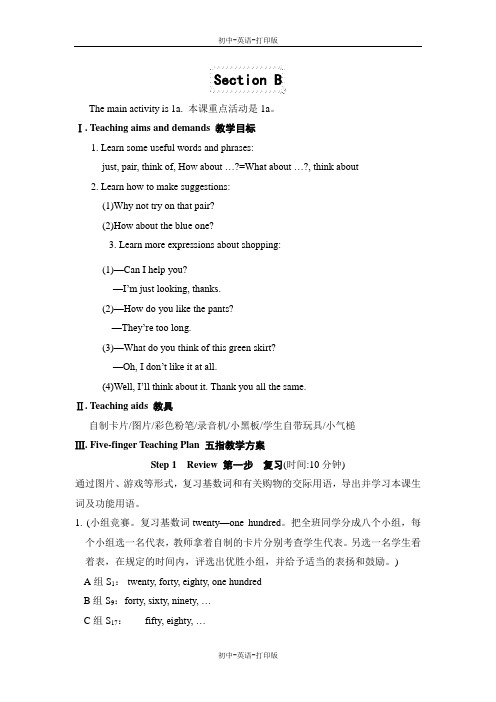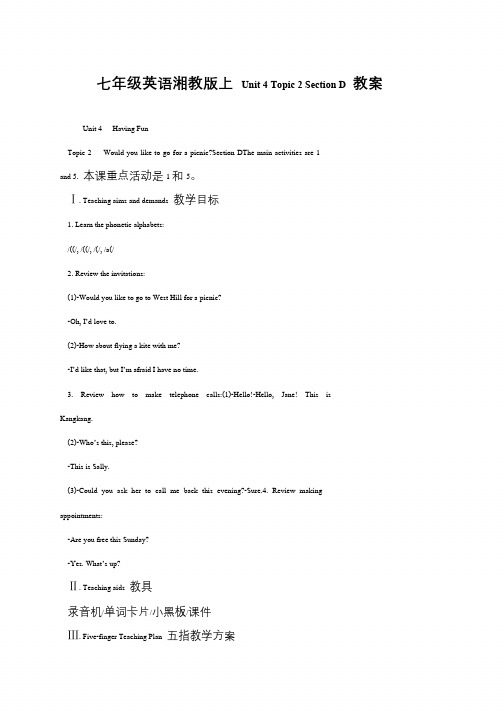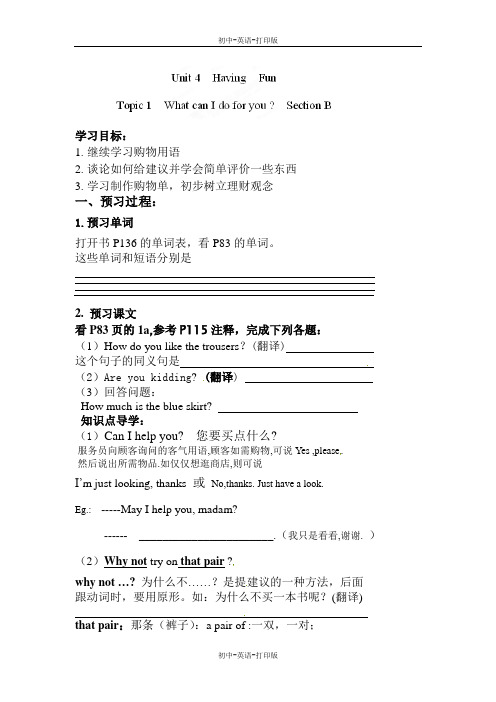七年级英语湘教版上册_4
湘教版-英语-七上-湘教版七上 4单元 Topic1 SectionD

Unit 4 Topic 1 :What can I do for you?Section D一学习目标:1.复习可数名词与不可数名词。
2.复习some 和any 的用法3. 复习有关购物的功能用语二学习重点:可数名词与不可数名词。
milk, salt, rice, bread, juice, a glass of apple juice, six bottles of milk, three bags of salt三学习难点:some 和any 的用法四学习过程:(一)导入:教师设置题目,让学生自由交谈。
复习目标语言,增强学生对购物用语的理解,导入新课。
(二)自学指导:让学生小组讨论三问题导学:1复习some, any的用法,引导学生理解并掌握some的特殊用法。
(四)典题训练:根据总结,用a, an, some, any填空。
①I have desk. ②They don’t have rulers.③She has eraser. ④Would you like water?⑤I’ll buy bottle of milk.⑥Do you need bags of oranges?⑦They would like glasses of apple juice.⑧She doesn’t have English book.(五)精讲点拨:Welcome to our food shop. All the things are on sale(降价出售)! Do you need vegetables? We have many kinds of vegetables. They are very cheap(便宜). Do you like milk? We have great milk, like Guangming, Mengniu, Yili and so on(等等), for just one yuan a bottle. Do you like chicken? Chicken is just for twelve yuan a kilo. Beef(牛肉) is for only eighteen yuan a kilo. Fish is for eight yuan a kilo. Come with your family and friends!( )1. They sell(卖) ____ in the shop.A. capsB. clothesC. shoesD. milk( )2. Two bottles of milk is just ____ yuan.A. 1B. 2C. 0.5D. 1.5( )3. A kilo of chicken is ____ yuan.A. 2B. 12C. 20D. 24( )4. Beef is ____ yuan half a kilo(0.5千克).A. 9B. 18C. 36D. 8( )5. I need two kilos of fish. It’s ____ yuan.A. 8B. 4C. 16D. 20五、作业:阅读理解Do you know the Lantian Clothes Shop? The clothes in the shop are very good. Look at the brown dress. It’s very nice. And it’s just 60 yuan. The red skirt looks cool and it’s just 35 yuan. Look! There are many caps. And it has all kinds of T-shirts and shoes. Boys and girls, welcome to the Lantian Clothes Shop.根据短文内容,判断正(T)误(F)。
湘教版-英语-七上-4单元 topic2 sectionc五指教学方案

Section CThe main activity is 1a. 本课重点活动是1a。
Ⅰ. Teaching aims and demands 教学目标1. Learn the useful phrase:have a picnic2. Talk about the invitations:(1)—Would you like to have a picnic with old McDonald?—Yes, I’d love to.—Thanks. That would be very nice.(2)—What about having a picnic with old McDonald?—I’d like that, thanks.(3)—How about having some apple juice?—Good idea!/All right.Ⅱ. Teaching aids 教具小黑板/图片/幻灯片/挂图/录音机Ⅲ. Five-finger Teaching Plan 五指教学方案Step 1 Review 第一步复习(时间:7分钟)复习、总结征求意见的表达方式及其回答,培养学生观察、总结和运用语言知识的能力。
1. (教师出示小黑板,要求学生按示范练习。
)T: We have learnt“Would you like to …? How about …? What about …?”. Let’s practice them. Please look at the small blackboard. Make a dialog using the expressions on it. After practice, please act it out in front of the class.(小黑板内容如下:)Would you like to …? Howabout …?(运用下列短语。
湘教版-英语-七上-4单元 topic2 sectionb五指教学方案

Section BThe main activities are 1a, 2a and 3. 本课重点活动是1a、2a和3。
Ⅰ. Teaching aims and demands 教学目标1. Learn some useful words and expressions:sing, song, have to, fun, fly, kite, fly a kite, afraid, time, carry, speak to, ask, back, call … back2. Learn to make invitations:(1)—Would you like to sing some songs with me?—I’m sorry I can’t. I have to cook.(2)—Steve, how about flying a kite with me?—I’d like that, but I’m afraid I have no time.3. Learn about making telephone calls:(1)Hello! May I speak to Maria?(2)Who’s this, please?(3)—Could you ask her to call me back this evening?—Sure.Ⅱ. Teaching aids 教具教学挂图/录音机/幻灯片/小黑板/课件/电话机Ⅲ. Five-finger Teaching Plan 五指教学方案Step 1 Review 第一步复习(时间:10分钟)通过复习预约野餐的电话会话,过渡到野餐情境,呈现本课生词和交际用语,调动学生学习的积极性。
1. (找两三组同学上台表演上节课中的1a电话会话。
掌声鼓励。
)2. (出示1a图片,通过师生对话导入新课。
)T: Look at the picture. Now they are very happy. Kangkang, Michael and Wang Junfeng are cooking. Cooking is fun. But now they have no water. Who’d like to help them carry some water?(板书并要求学生掌握。
湘教版-英语-七上- 4单元 Topic1 What can I do for you

学习目标:1.继续复习可数名词和不可数名词量的表达2.继续复习购物的功能用语3.继续复习some、any的用法一、课前习题:1.掌握可数名词和不可数名词的量的表达,翻译短语:(1)a kilo of bananas _______(2)一杯牛奶___________(3)两瓶桔汁__________ (4)两公斤苹果____________(5)three bowls(碗)of rice ______(6)一袋大米______(7)a cup of tea___________ (8)两杯咖啡___________ (9)四盒铅笔__________(10)a piece of cake__________ (11)一条裤子____________(12)五公斤鱼___________ (13)一些果汁____________(14)一些蔬菜___________(15) 许多学生___________ (16) 许多水___________2. some和any 的用法(1)I want to buy _____ bread.(2)He doesn’t like _____ fish.(3)Do you have _____ vegetables? Yes, give me _______. (4)Could you help me do _____shopping?(5)Would you like to have ____ chicken?(6)I have _____ eggs and milk for breakfast.(7)What about _____ tea?总结some和any 的用法:二、课堂习题:Grammar, Functions , 2, 1, 3 三、单元检测:(1)We have some rice.(一般疑问句) _____you ____ ____ rice?(2)The pants are 189 yuan.(对划线提问) ____ _____ are the pants? (3)They need six bottles of water.( 对划线提问)_____ _____ bottles of water do they need?(4)Mom buys me some new clothes.(同义句转换)Mom _____ some new clothes _____ me.(5)May I help you? (同义句转换)_____ _____ I_____ _____ you?(6)How do you like the shirts? (同义句转换)_____do you ____ ____ this green skirt?。
湘教版英语七上Units1-4知识点归纳

七(上)Units 1-4知识点归纳班级:_______________ 姓名:_________________座号:_______________ Ⅰ、实义动词的第三人称单数及现在分词形式。
A)类ask-asks-asking be-/-beingbring-brings-bringing buy-buys-buyingcall-calls-calling carry-carries-carryingcolor-colors-coloring cook-cooks-cookingcry-cries-crying do-does-doingdress-dresses-dressing drink-drinks-drinkingeat-eats-eating find-finds-findingfly-flies-flying go-goes-goingguess-guesses-guessing hand-hands-handinghelp-helps-helping know-knows-knowinglist-lists-listing look-looks-lookingmeet-meets-meeting need-needs-needingorder-orders-ordering pick up-picks up-picking upplay-plays-playing say-says-sayingsee-sees-seeing sing-sings-singingsleep-sleeps-sleeping speak-speaks-speakingspell-spells-spelling stand-stands-standingstart-starts-starting study-studies-studyingteach-teaches-teaching tell-tells-tellingthink-thinks-thinking try-tries-tryingvisit-visits-visiting wait-waits-waitingwant-wants-wanting watch-watches-watchingworry-worries-worrying work-works-workingB)类begin-begins-beginning forget-forgets-forgettingget-gets-getting kid-kids-kiddinglet-lets-letting run-runs-runningset-sets-setting shop-shops-shoppingsit-sits-sitting swim-swims-swimmingC)类come-comes-coming drive-drives-drivingexcuse-excuses-excusing face-faces-facinggive-gives-giving have-has-havinglike-likes-liking live-lives-livinglove-loves-loving make-makes-makingphone-phones-phoning take-takes-takingtelephone-telephones-telephoningⅡ、重点词(组)、句归纳。
湘教版-英语-七上-4单元 topic1 sectionb五指教学方案

Section BThe main activity is 1a. 本课重点活动是1a。
Ⅰ. Teaching aims and demands 教学目标1. Learn some useful words and phrases:just, pair, think of, How about …?=What about …?, think about2. Learn how to make suggestions:(1)Why not try on that pair?(2)How about the blue one?3. Learn more expressions about shopping:(1)—Can I help you?—I’m just looking, thanks.(2)—How do you like the pants?—They’re too long.(3)—What do you think of this green skirt?—Oh, I don’t like it at all.(4)Well, I’ll think about it. Thank you all the same.Ⅱ. Teaching aids 教具自制卡片/图片/彩色粉笔/录音机/小黑板/学生自带玩具/小气槌Ⅲ. Five-finger Teaching Plan 五指教学方案Step 1 Review 第一步复习(时间:10分钟)通过图片、游戏等形式,复习基数词和有关购物的交际用语,导出并学习本课生词及功能用语。
1. (小组竞赛。
复习基数词twenty—one hundred。
把全班同学分成八个小组,每个小组选一名代表,教师拿着自制的卡片分别考查学生代表。
另选一名学生看着表,在规定的时间内,评选出优胜小组,并给予适当的表扬和鼓励。
)A组S1: twenty, forty, eighty, one hundredB组S9:f orty, sixty, ninety, …C组S17:fifty, eighty, …D组S25:seventy, ninety, ……2. (教师出示一幅一个男人正在商场买鞋的图片, 复习购物用语,引出新词汇。
七年级英语湘教版上 Unit 4 Topic1 SectionA课件

shoes ¥ 135
2c
Work alone
dress
skirt
T-shirt
pants
1.sixteen sixty
2.eighteen
eighty
3.seventeen
seventy
4.fifteen
fifty
Questions
1.What do they want to buy? They want to buy clothes. 2.Where are the clothes? The clothes are over there. 3.What color is Maria’s new dress? It’s yellow.
根据汉语提示完成句子
• • • • • • • • • • 1.我想给我儿子买些鱼肉。 fish for I want to buy some ____ ____ my son. 2.这双鞋很好,我们买下了。 The shoes are nice.We will____ take/buy____. them 3.我喜欢这条裤子。我能试一试吗? pants Can try them I like the ____ .____ I____ _____ on? 4.我的爷爷今年99岁。 ninety-nine ____ My grandfather is _________ years old. 5.多谢。不用谢。 Not at all Thanks a lot.______ _____ _____ .
It’s nineteen.
4. What’s eight and two? It’s ten.
5. What’s five and nine?
七年级英语湘教版上 Unit 4 Topic 2 Section D 教案

动员,人人参与。)
T:Everyonehasacard.IfIread/((/,thestudentswiththe/((/cardstandup,
(1)选择题
①Would you like _____ with me? Yes,I’dlove to.
LingbutXiaoLing’smotheranswersthephone.Workingroupsofthree.Thefirst
and the best groups will get two scores.Example:S1:Hello!
S2:Hello, may I speak to Xiao Ling?
S1:Wait a moment....S3:Hello!
S2:Hello, Xiao Ling. This is Xiao Mei.
S3:Hi, Xiao Mei.
S2:Are you free tomorrow?
S3:Yes.What’sup?
S2:Iwanttogotothebookshoptobuysomebooks.Wouldyouliketogowith
C.has a picnic with old Tom.
D.having a picnic with old Tom.
③Would you like to go shopping with us? _____.
-I’dlike that, butI’mafraid I have no time.
3.Reviewhowtomaketelephonecalls:(1)-Hello!-Hello,Jane!Thisis
湘教版七年级英语上册Unit4 Having Fun(2)

Unit 4 Having Fun第一课时学习目标知识目标1.重点短语clothes section, how much/many, not at all, try on, running shoes, run over, a few, all right, pick up2.语法:(1) How much is/are ...? It's / They're ...(2) 可数名词和不可数名词3.句型:(1) Can I help you? / What can I do for you?(2) Thanks a lot. Not at all.(3) How much is it? It is only 70 yuan.(4) We are just looking.(5) How do the pants fit?(6) Would you like to try on another pair?(7) How do you like...?(8) Well, thanks anyway.(9) How much are they? They are 80 yuan.(10) Sure.(11) All right.(12) 80 yuan! Are you kidding?语法聚焦1.How much + ...? 询问某物的价格。
如:-- How much is the meat? 这肉多少钱?-- It's ¥6.50. -- 6块5。
-- How much is that watch? 那手表价格多少?-- It's ¥200. -- 200元。
-- How much are these pants? 这些裤子要多少钱?-- They're ¥180. -- 180元。
2.可数名词和不可数名词(1) 名词按其所表示事物的性质分为可数名词和不可数名词。
湘教版-英语-七上- 4单元 Topic1 What can I do for you

学习目标:1.学习可数名词和不可数名词数量的表达和重量的表达2.学习如何询问可数名词和不可数名词的数量、重量。
3.学习表示需求的表达4. 学习some /any的用法5. 继续学习购物用语建议用2课时一、预习过程:1.看书P117,学习名词,重点学习可数名词和不可数名词2.预习单词打开P85-86的单词表,看P 85-86的单词,完成下题。
写出下列单词的汉语:kilo kilo(复数形式) bagloaf bar bottle tin以上都是名词,同时它们可用来表示物的“量”或“数量”a kilo of : 一公斤…,two kilos of 两公斤…a bag of 一袋…three bags of三袋…a bottle of ten bottles of…………本课还有六个新单词,3. 预习课文看P85页的1a,参考P115的课文注释完成下列各题(1)Big Sale! Buy more and save more!(翻译)(2)Could you help me do some shopping?(翻译)do some shopping : = do the shopping=go shopping 买东西,购物类似的表达有: do some/the cleaning ___________________do some/the reading _____________________-知识点导学:1. We need two kilos of apples and some rice.need :表示需求,后接名词或to do她需要你的帮助___________ 我需要买点牛奶______________two kilos of…“两千克……”英语中量”的表达,分为两种①数词+ 容器+ of:I’d like two bottles of water.②数词+ 表示量的名词+ of: 5 kilos of oranges. 如:a pair of___________ ten pieces of③若修饰的名词为不可数名词,表示数量时名词复数体现在量词上. a bag of rice __________ three bag s of rice _____________2. 问数量:how many+可数名词复数形式如:________________how much + 不可数名词如:________________问重量:how heavy3. some和any的用法:二者都表示“一些”,都可修饰可数和不可数名词,some用在肯定句中,any 用在否定句和疑问句中,如:We have some milk but they don’t have any milk二、课堂活动:3 , 2a, 1a, 1b, 1c, 2b三.随堂检测:A.根据首字母提示或汉语要求完成句子1. Could you please help me do some s______, Jane?2. The bag of rice is too h______. Can you help me?3. --Is that a_____? -- No , I need some eggs, too.4. I’d like to buy _____ _____ ____ _____(2千克大米).5. I want some fish.(改为否定句) I ____ want ____ fish.6. bottles, of, milk, need, they, do, many, how(连词成句)_______________________________________________。
湘教版-英语-七上- 4单元 Topic1 What can I do for you

学习目标:1.继续学习购物用语2.谈论如何给建议并学会简单评价一些东西3.学习制作购物单,初步树立理财观念一、预习过程:1.预习单词打开书P136的单词表,看P83的单词。
这些单词和短语分别是2. 预习课文看P83页的1a,参考P115注释,完成下列各题:(1)How do you like the trousers?(翻译)这个句子的同义句是(2)Are you kidding? (翻译)(3)回答问题:How much is the blue skirt?知识点导学:(1)Can I help you? 您要买点什么?服务员向顾客询问的客气用语,顾客如需购物,可说Yes ,please.然后说出所需物品.如仅仅想逛商店,则可说I’m just looking, thanks或No,thanks. Just have a look.Eg.: -----May I help you, madam?------ _______________________.(我只是看看,谢谢.)(2)Why not try on that pair ?why not …? 为什么不……?是提建议的一种方法,后面跟动词时,要用原形。
如:为什么不买一本书呢?(翻译) that pair:那条(裤子):a pair of :一双,一对;two pairs of :两双,两对,如:两双鞋:作主语时,谓语动词与pair保持一致,如:( 用is 或are填空) This pair of trousers red and those two pairsof shoes pink pair.(3)How about the blue one ? (翻译)How about …= what about…用于征求意见或询问消息,后跟名词, 代词, 若碰到动词,跟doing(动词的-ing形式)的形式. 翻译句子:I’d like some fish. How about you? ___________________What about eating out?_________________________(4)Thank you all the same= Thank you anyway. (翻译)用于对方无法提供你要求的帮助,或你不需要对方帮助时的答语看P84页的2a,预习询问物品的价格___ ___ ____ the T-shirt¥1oo.00______ __ .二、课堂活动:3 , 2a, 1a, 1b, 1c, 2b三、随堂检测:按要求完成句子:1.What do you think of this coat? (同义句______ do you _____ this coat?2. May I help you? (同义句):_____ _____ I do _____ you?3. This bag of rice is 52 yuan.(划线提问) ___ ____ is this bag of rice?4. 嗯,让我考虑一下. Well, I’ll _____ _____ it.5. 这件红裙子怎么样?_____ _____ this red dress?根据首字母或汉语提示完成句子:1. What do you ______ _____ (认为) the dress?2. why not _____ ______(试穿) that blue pair?3. Mary, your dress is ______ _____(太长).4. --Can I help you ? ---We’re ______ ______ (只是看看), thanks.5. I’ll _____ _____ (考虑) that yellow jacket.6. Jim’s shoes are too old. I want to buy a new ______(一双) for him.7. Please make _____ _____ (一张购物单) .。
- 1、下载文档前请自行甄别文档内容的完整性,平台不提供额外的编辑、内容补充、找答案等附加服务。
- 2、"仅部分预览"的文档,不可在线预览部分如存在完整性等问题,可反馈申请退款(可完整预览的文档不适用该条件!)。
- 3、如文档侵犯您的权益,请联系客服反馈,我们会尽快为您处理(人工客服工作时间:9:00-18:30)。
七年级英语湘教版上册英语知识点总结与测试题【知识梳理】I. 重点短语1. Sit down2. on duty3. in English4. have a seat5. at home6. look like7. look at8. have a look9. come on10. at work11. at school12. put on13. look after14. get up15. go shoppingII. 重要句型1. help sb. do sth.2. What about…?3. Let’s do sth.4. It’s time to do sth.5. It’s time for …6. What’s…? It is…/ It’s…7. Where is…? It’s….8. How old are you? I’m….9. What class are you in? I’m in….10. Welcome to….11. What’s …plus…? It’s….12. I think…13. Who’s this? This is….14. What can you see?I can see….15. There is (are) ….16. What colour is it (are they)? It’s (They’re)…17. Whose …is this? It’s….18. What time is it? It’s….III. 交际用语1. Good morning, Miss/Mr….2. Hello! Hi!3. Nice to meet you. Nice to meet you, too.4. How are you? I’m fine, thank you/thanks. And you?5. See you. See you later.6. Thank you! You’re welcome.7. Goodbye! Bye!8. What’s your name? My name is ….9. Here you are. This way, please.10. Who’s on duty today?11. Let’s do.12. Let me see.IV. 重要语法1. 动词be的用法;2. 人称代词和物主代词的用法;3. 名词的单复数和所有格的用法;4. 冠词的基本用法;5. There be句型的用法。
【名师讲解】1. in/on在表示空间位置时,in表示在某个空间的范围以内,on表示在某一个物体的表面之上。
例如:There is a bird in the tree. 树上有只鸟。
There is a picture on the wall. 墙上有张图。
2. this/that/these/those(1)this常常用来指在时间、地点上更接近讲话人的人和事,these是this的复数形式。
that常常用来指在时间、地点上离讲话人更远一点的人和事,those时that的复数形式。
例如:You look in this box and I’ll look in that one over there.你看看这个盒子,我去看那边的那个盒子。
I want this car, not that car. 我想要这辆小汽车,不是那一辆。
Take these books to his room, please. 请把这些书拿到他房间去。
This is mine; that’s yours. 这个是我的,那个是你的。
These are apples; those are oranges. 这些是苹果,那些是橘子。
(2)在打电话的用语中,this常常指的是我,that常常指的是对方。
例如:This is Mary speaking. Who’s that? 我是玛丽。
你是谁?3. There be/ haveThere be "有",其确切含意为"某处或某时存在某人或某物。
"其结构是:There be + 某人或某物+ 表示地点或时间的状语。
There be 后面的名词实际上是主语,be 动词的形式要和主语在数上保持一致,be动词后面的名词是单数或不可数名词时用is,名词是复数时用are。
例如:(1) There is a big bottle of coke on the table. 桌上有一大瓶子可乐。
(2) There is a doll in the box. 那个盒子里有个娃娃。
(3) There are many apples on the tree. 那树上有许多苹果。
总之,There be结构强调的是一种客观存在的"有"。
have表示"拥有,占有,具有",即:某人有某物(sb. have / has sth.)。
主语一般是名词或代词,与主语是所属关系。
例如:(4) I have two brothers and one sister.我有两个兄弟,一个姐姐。
(5) That house has four rooms.那所房子有四个房间。
4. look/ see/ watch(1)look 表示“看、瞧”,着重指认真看,强调看的动作,表示有意识地注意看,但不一定看到,以提醒对方注意。
,如:Look! The children are playing computer games. 瞧!孩子们在玩电脑游戏。
Look! What’s that over there? 看!那边那个是什么?单独使用是不及物动词,如强调看某人/物,其后接介词at,才能带宾语,如:He’s looking at me。
他正在看着我。
(2)see强调“看”的结果,着重的是look这个动作的结果,意思是“看到”,see是及物动词,后面能直接跟宾语。
如:What can you see in the picture? 你能在图上看到什么?Look at the blackboard. What did you see on it?看黑板!你看到了什么?(3)watch“观看,注视”,侧重于场面,表示全神贯注地观看、观察或注视某事务的活动,强调过程,常用于“看电视、看足球、看演出”等。
如:Yesterday we watched a football match on TV.昨天我们从电视上看了一场足球比赛。
4. put on/ / input on意为“穿上,戴上”。
主要指“穿上”这一动作, 后面接表示服装、鞋帽的名词。
in 是介词,表示“穿着”强调状态。
在句中可以做定语、标语和状语。
如:It’s cold outside, put on your coat. 外面冷,穿上你的外衣。
He puts on his hat and goes out. 他戴上帽子,走了出去。
The woman in a white blouse is John’s mother.穿白色衬衣的那个妇女是John的妈妈。
5. house/ home/familyhouse :“房子”,指居住的建筑物; Home: “家”,指一个人同家人共同经常居住的地方; Family: “家庭“,“家庭成员”。
例如:Please come to my house this afternoon. 今天下午请到我家来。
He is not at home. 他不在家。
My family all get up early. 我们全家都起得很早。
6. fine, nice, good, well四者都可用作形容词表示"好"之意,但前三者既可作表语又可作定语,而后者仅用作表语。
主要区别在于:(1) fine指物时表示的是质量上的"精细",形容人时表示的是"身体健康",也可以用来指"天气晴朗"。
例如:Your parents are very fine. 你父母身体很健康。
That's a fine machine. 那是一台很好的机器。
It's a fine day for a walk today. 今天是散步的好时候。
(2)nice主要侧重于人或物的外表,有"美好","漂亮"的意思,也可用于问候或赞扬别人。
例如:Lucy looks nice. 露西看上去很漂亮。
These coats are very nice. 那些裙子很好看。
Nice to meet you. 见到你很高兴。
It's very nice of you. 你真好。
(3)good形容人时指"品德好",形容物时指"质量好",是表示人或物各方面都好的普通用语。
例如:Her son is a good student. 她儿子是一个好学生。
The red car is very good. 那辆红色小汽车很好。
(4)well只可用来形容人的"身体好",但不能作定语,它也能用作副词作状语,多放在所修饰的动词之后。
例如:I'm very well, thanks. 我身体很好,谢谢。
My friends sing well. 我的朋友们歌唱得好。
【考点扫描】中考考点在本单元主要集中在:1. 动词be的用法;2. 人称代词和物主代词的用法;3. 名词的单复数和所有格的用法;4. 冠词的基本用法;5. There be句型的用法。
6. 本单元学过的词汇、短语和句型;7. 本单元学过的日常交际用语。
考试形式可以是单项填空、完型填空、短文填空、完成句子。
【中考范例】1. (2004年北京市中考试题)Mary, please show ________ your picture.A. myB. mineC. ID. me【解析】答案:D。
该题考查的是人称代词和物主代词的用法。
本题中动词show后面跟双宾语,空白处应填入人称代词的宾格me作宾语。
2. (2004年上海市徐汇区中考试题)_________ orange on the desk is for you, Mike.A. AB.AnC. /D. The【解析】答案:D。
该题考查的是冠词的基本用法。
因为是特指课桌上的那个橘子,所以用定冠词the。
3. (2004年哈尔滨市中考试题)---What _______ the number of the girls in your class?---About twenty.A. isB. amC. areD. be【解析】答案:A。
